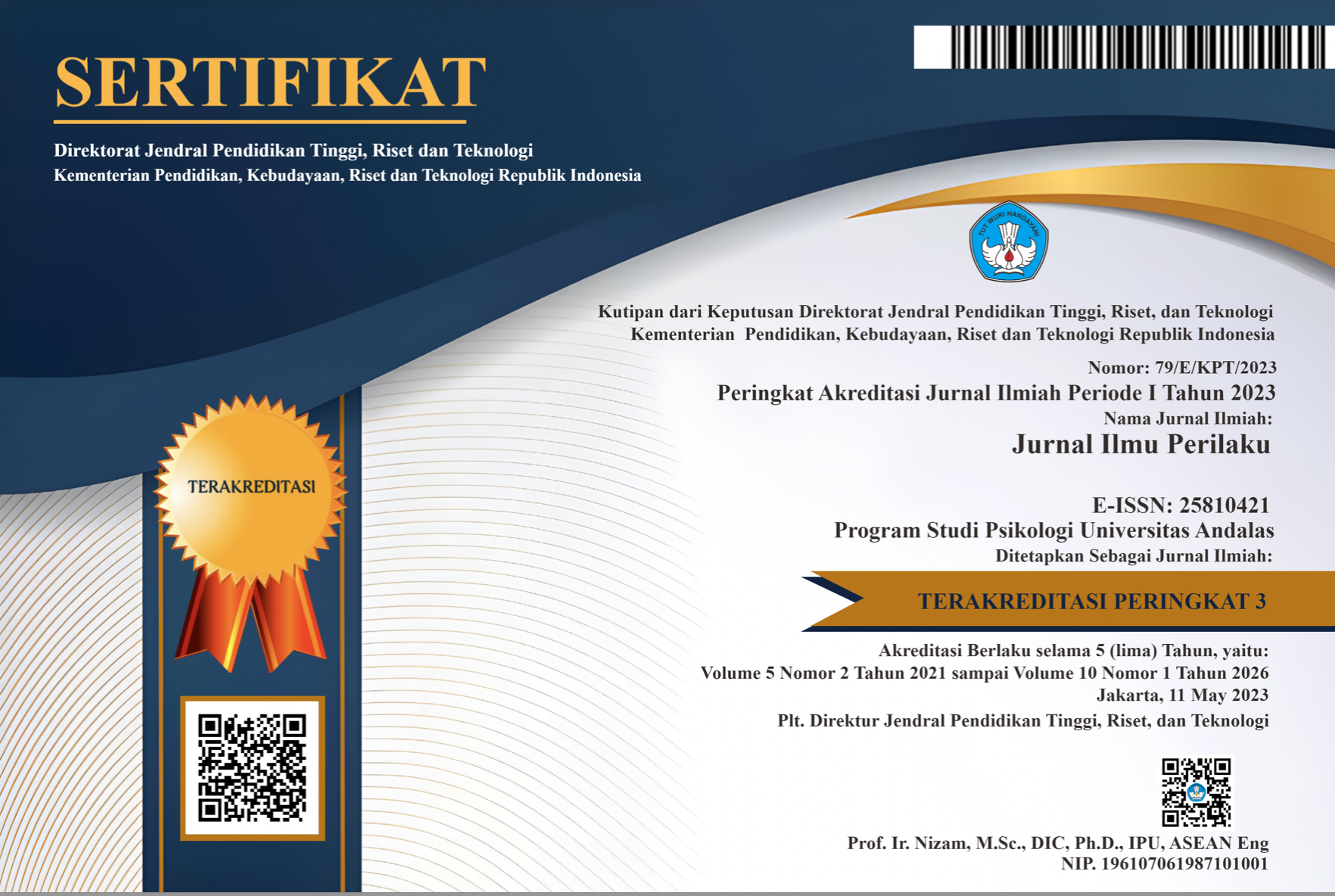External Locus of Control and Demographic Data as Determinant Factors of Trauma Resilience: A Study among Young Women Who Were Exposed to Violence
Abstract
The number of violent incidents on women is increasing every year in Indonesia. Some women can survive through traumatic experiences, and it is related to their resilience. Locus of control (LoC) is known to contribute to resilience by enhancing individuals’ self- control and problem-solving behavior. This study aims to determine the role of LoC in trauma resilience among 134 young women (20 – 40 years old) who were exposed to violence (domestic, physical, and sexual) and a minimum of high school education. This study used a quantitative approach with the Locus of Control Scale (α = 0.732, 18 items) and the Trauma Resilience Scale (α = 0.961, 48 items). Two hypotheses are proved in this study: (1) external LoC significantly contributes to trauma resilience (p = .000, R2 = .139), (2) there is a significant difference between violence exposure (<.001), perpetrators (.005), and disclosure to others about their experience of violence (.009). We also found that no participants reported a dominant internal LoC, so future studies are advised to focus on women who were exposed to violence with a more dominant internal LoC.
Downloads
References
Alho, C. M. (2015). The social effects of the exposure to domestic violence during childhood: A Socio- Educational Perspective. Africa: University of South Africa.
American Pscyhological Association. (2019). The road to resilience. Retrieved from www.apa.org: https://www.apa.org/helpcenter/roa d-resilience
Anderson, K. M., Renner, L. M., & Danis, F. S. (2012). Recovery: Resilience and Growth in the Aftermath ofDomestic Violence. Violence Against Women, 18(11), 1279–1299. https:// doi.org/10.1177/1077801212470543
Asberg, K., & Renk, K. (2014). Perceived stress, external locus of control, and social support as predictors of psychological adjustment among female inmates with or without a history of sexual abuse. International Journal of Offender Therapy and Comparative Criminology, 58(1), 59–84. https://doi.org/10.1177/0306624X1246 1477
Burt, K. B., & Paysnick, A. A. (2012). Resilience in the transition to adulthood. Development and Psychopathology, 24(2), 493–505. https://doi.org/10.1017/S09545794120 00119
Carlson, E. B., & Dalenberg, C. J. (2000). A Conceptual Framework for the Impact of Traumatic Experiences. Trauma, Violence, & Abuse, 1(1), 4–28. https://doi.org/10.1177/152483800000 1001002
Cazan, A.-M., & Dumitrescu, S. A. (2016).
Exploring the relationship between adolescent resilience, self-perception and locus of control. (September), 283–286. https://doi.org/10.15303/rjeap.2016.si 1.a61
Collins, A. M., & Swearer, S. M. (2012). Dating violence. School Psychologist.
Domhardt, M., Münzer, A., Fegert, J. M., & Goldbeck, L. (2015). Resilience in Survivors of Child Sexual Abuse: A Systematic Review of the Literature. Trauma, Violence, and Abuse, 16(4), 476–493. https://doi.org/10.1177/152 4838014557288
Dyson, J., Cobb, M., & Forman, D. (1997). The meaning of spirituality: a literature review. Journal of Advanced Nursing, 26(6), 1183–1188. https://doi. org/10.1111/j.1365-2648.1997.tb00811 .x
Hood, S. K., & Carter, M. M. (2008). A preliminary examination of trauma history, locus of control, and PTSD symptom severity in African American women. Journal of Black Psychology, 34(2), 179–191. https://doi.org/10.1177/009579840731 0541
Huntley, F. L., Palmer, E. J., & Wakeling, H. C. (2012). Validation of an adaptation of levenson's locus of control scale with adult male incarcerated sexual offenders. Sexual Abuse: A Journal of Research and Treatment, 61.
Jamison, L. (2016). Depression and resilience among young adult colleges students with varying victimization experiences. Research Gate.
Madsen, M. D., & Abell, N. (2010). Trauma resilience scale: Validation of protective factors associated with adaptation following violence. Research on Social Work Practice, 20(2), 223–233. https://doi.org/10. 1177/1049 731509347853
Masson, V. L., Benoudji, C., Reyes, S. S., & Bernard, G. (2017). Violence against women and girls and resilience. French: Braced Knowledge Manager.
Masten, A. S., Burt, K. B., Roisman, G. I., Obradović, J., Long, J. D., & Tellegen, A. (2004). Resources and resilience in the transition to adulthood: Continuity and change. Development and Psychopathology, 16(4), 1071–1094. https://doi.org/10.1017/S0954579404 040143
Mellon, R. C., Papanikolau, V., & Prodromitis, G. (2009). Locus of control and psychopathology in relations to levels of trauma and loss: self reports of Peloponnesian wildfire survivors. Journal of Traumatic Stress, 193-195. doi:10.1002/jts.20411.
Memmi, D. (2017). Comparative foundations of Eastern and Western thought. AI and Society, 32(3), 359– 368. https://doi.org/10.1007/s00146- 016-0656-5
Moya, A. (2018). Violence, psychological trauma, and risk attitudes: Evidence from victims of violence in Colombia. Journal of Development Economics, 131, 15–27. https://doi.org/ 10.1016/j.jdeveco.2017.11.001
O'Flaherty, M. (2019). Women as victims of partner violence: Justice for victims of violent crime part IV. Belgium: European Union Agency for Fundamental Rights.
Phillips, J., & Vandenbroek, P. (2014). Domestic violence in Australia: an overview of the issues. Parliamentary Library Research Paper, (October), 42. Retrieved from http://parlinfo.aph. gov.au/parlInfo/download/library/pr spub/1246402/upload_binary/124640 2.pdf;fileType=application/pdf#searc h=%22background note (parliamen tary library, australia)%22%5Cn http ://agent.capmon.com/facsnet/cgi-bin /facsserve_document.cgi/facs/p
Roazzi, A., Attili, G., Di Pentima, L., & Toni, A. (2016). Locus of control in maltreated children: The impact of attachment and cumulative trauma. Psicologia: Reflexao e Critica, 29(1). https://doi.org/10.1186/s41155-016- 0025-9
Rotter, J. B. (1966). Generalized expectancies for internal versus external control of reinforcement. Psychological Monographs: General and Applied, 1.
Specht, J., Egloff, B., & Schmukle, S. C. (2011). The benefits of believing in chance or fate: External locus of control as a protective factor for
coping with the death of a spouse.
Social Psychological and Personality Science, 2(2), 132–137. https://doi.org /10.1177/1948550610384635
Spilsbury, J. C., Belliston, L., Drotar, D., Drinkard, A., Kretschmar, J., Creeden, R., ... Friedman, S. (2007). Clinically significant trauma symptoms and behavioral problems in a community-based sample of children exposed to domestic violence. Journal of Family Violence, 22(6), 487–499. https://doi.org/10.10 07/s10896-007-9113-z
Stapleton, P. B., & Yamaoka, T. (2015). Exploring the links between culture, locus of control and self-compassion and their roles in the formation of weight stigmatization. The New School Psychology Bulletin, 13(2), 32– 46.
Thureau, S., Blanc-Louvry, L., Thureau, S., Gricourt, C., & Proust, B. (2015). Conjugal violence: A comparison of violence against men by women and women by men. Journal of Forensic and Legal Medicine, 42-46. doi:10.1016 /j.jflm.2014.12.014
Ungar, M. (2013). Resilience, Trauma, Context, and Culture. Trauma, Violence, and Abuse, 14(3), 255–266. https://doi.org/10.1177/152483801348 7805
Valentine, L., & Feinauer, L. L. (2007). Resilience factors associated with female survivors of childhood sexual abuse. American Journal of Family Therapy, 21(3), 216–224. https://doi.org/10.1080/019261893082 50920https://doi.org/10.1080/0192618 9308250920
World Health Organization. (2012). Intimate partner violence - World Health Organization. Retrieved from apps.who.int: https://apps.who.int /iris/bitstream/handle/10665/77432/W HO_RHR_12.36_eng.pdf;jsessionid=F
The non-commercial use of the article is governed by the Creative Commons Attribution license as currently displayed on Creative Commons Attribution-NonCommercial-ShareAlike 4.0 International License.
JIP's spirit is to disseminate articles published are as free as possible. Under the Creative Commons license, JIP permits users to copy, distribute, display, and perform the work for non-commercial purposes only. Users will also need to attribute authors and JIP on distributing works in the journal.
Please find the rights and licenses in Jurnal Ilmu Perilaku (JIP).
- License
The non-commercial use of the article will be governed by the Creative Commons Attribution license as currently displayed on Creative Commons Attribution-NonCommercial-ShareAlike 4.0 International License.
- Author’s Warranties
The author warrants that the article is original, written by stated author(s), has not been published before, contains no unlawful statements, does not infringe the rights of others, is subject to copyright that is vested exclusively in the author and free of any third party rights, and that any necessary written permissions to quote from other sources have been obtained by the author(s).
- User Rights
JIP's spirit is to disseminate articles published are as free as possible. Under the Creative Commons license, JIP permits users to copy, distribute, display, and perform the work for non-commercial purposes only. Users will also need to attribute authors and JIP on distributing works in the journal.
- Rights of Authors
Authors retain the following rights:
- Copyright, and other proprietary rights relating to the article, such as patent rights,
- The right to use the substance of the article in future own works, including lectures and books,
- The right to reproduce the article for own purposes, provided the copies are not offered for sale,
- The right to self-archive the article.
- Co-Authorship
If the article was jointly prepared by other authors, the signatory of this form warrants that he/she has been authorized by all co-authors to sign this agreement on their behalf, and agrees to inform his/her co-authors of the terms of this agreement.
- Termination
This agreement can be terminated by the author or JIP upon two months’ notice where the other party has materially breached this agreement and failed to remedy such breach within a month of being given the terminating party’s notice requesting such breach to be remedied. No breach or violation of this agreement will cause this agreement or any license granted in it to terminate automatically or affect the definition of JIP.
- Royalties
This agreement entitles the author to no royalties or other fees. To such extent as legally permissible, the author waives his or her right to collect royalties relative to the article in respect of any use of the article by JIP or its sublicensee.
- Miscellaneous
JIP will publish the article (or have it published) in the journal if the article’s editorial process is successfully completed and JIP or its sublicensee has become obligated to have the article published. JIP may conform the article to a style of punctuation, spelling, capitalization, referencing and usage that it deems appropriate. The author acknowledges that the article may be published so that it will be publicly accessible and such access will be free of charge for the readers.










